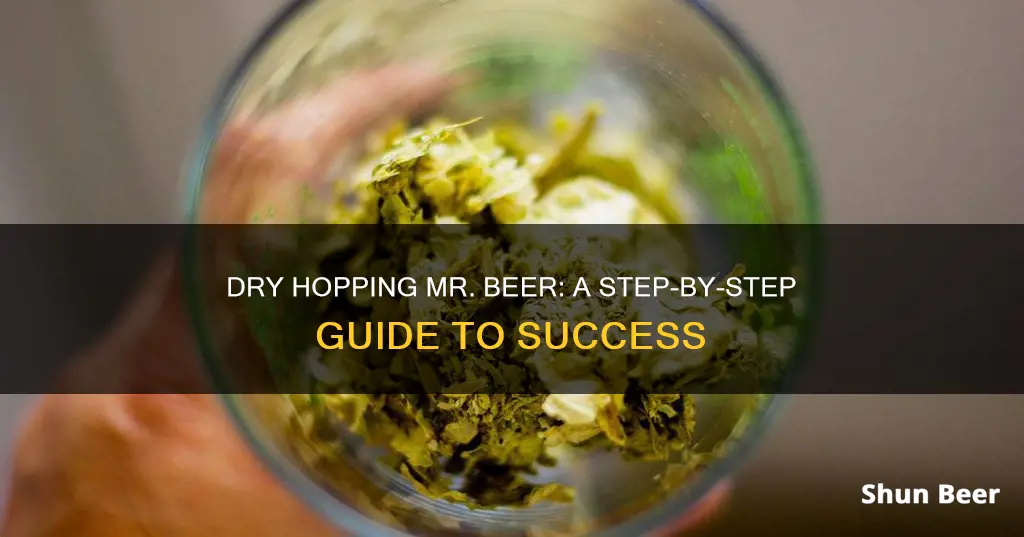
Dry hopping is the process of adding dried hops to your fermenting beer, usually during the later stages, to impart flavour and aroma without adding bitterness. The technique is often used for IPAs, NEIPAs and pale ales, but can be applied to any beer. Dry hopping can be done with whole leaf or pellet hops, and the amount used will depend on the desired level of aroma and the gravity of the beer. It's important to sanitise the equipment used for dry hopping to prevent infections, and to be mindful of the risk of oxidation when adding hops after fermentation.
What You'll Learn

Dry hopping process
Dry hopping is the process of adding dried hops to your beer during the later stages of fermentation, usually during or right after primary fermentation. It adds flavour and aroma from the hops without the bitterness associated with boiling hops in the wort.
Choosing Hops
When choosing hops for dry hopping, select hops from the Dual purpose/aroma category. Popular choices include Citra, Centennial, Cascade, Simcoe, Hallertau, and Tettnanger. You can also mix varieties for a more complex flavour profile.
Amount of Hops
The amount of hops used will depend on the desired aroma intensity and the gravity of the beer. As a general rule, use one ounce of hops per five gallons of average-strength beer for a mild aroma. For a stronger aroma or higher-gravity beers, you can use up to four to five ounces per five gallons.
Timing
Dry hopping can be done during primary fermentation, after fermentation, or even in the keg. Dry hopping during primary fermentation is common for IPAs, as the active yeast will transform hop oil compounds into new and distinctive flavours and aromas. However, adding hops too early may reduce some of the finer aromas and flavours. It is generally recommended to dry hop no earlier than day seven or eight of fermentation.
Dry Hopping Techniques
There are several techniques for dry hopping:
- Adding hops directly: The simplest method is to open the fermenter and add the hops directly. This provides the most flavour and aroma but can introduce unwanted oxygen, causing oxidation.
- Using a bag or mesh tube: Hops can be added in a sanitised stainless steel mesh tube or muslin bag to contain them and limit cleanup. However, this method may reduce flavour and will still add oxygen.
- Zero-oxygen dry hopping: This technique uses a custom-built hop dropper to add hops without introducing oxygen. It requires a fermenter with a stainless steel lid and an opening to hold a tri-clamp fitting.
- Hop tea or tincture: Place hops in a French press, add enough pale ale to cover them, and let it sit for 15 minutes. This method gives a preview of how the hops will contribute to the beer's flavour and aroma.
- Using a Randall or Hop Rocket: This technique involves running hot or chilled wort through a hop infuser, picking up hop flavour along the way.
Sanitation
It is important to sanitise any equipment that will come into contact with the beer, including scissors, tongs, and the hop sack if using one. However, there is no need to sanitise the hops themselves, as the alcohol in the beer and the antimicrobial properties of hops help prevent contamination.
Exploring Mexican-Style Beer: A Hoppy Adventure
You may want to see also

Hops types and quantities
The type and quantity of hops you use for dry hopping depend on the desired aroma and flavour profile of your beer. Dry hopping is typically done with hops that are considered "flavour" or "aroma" hops, which usually have a relatively low alpha-acid rating (around 6% or less).
Some popular varieties of hops used for dry hopping include Cascade, Crystal, Willamette, East Kent Golding, Fuggle, Saaz, Hallertau, Tettnanger, Citra, Centennial, Amarillo, Simcoe, Galaxy, Mosaic, and many more. These hops are often used for IPAs, NEIPAs, and other hoppy beer styles.
The quantity of hops used for dry hopping can vary depending on the desired intensity of the aroma and the gravity of the beer. A general rule of thumb for an average amount of aroma is to use one ounce of hops per five gallons of average-strength beer. For more hop aroma or in higher-gravity beers, you can use up to four to five ounces per five gallons or even more if you want to push the boundaries.
For example, for American pale ales, you can use between 0.5 and 1 ounce of hops per five-gallon batch. For IPAs, you can use up to 2 ounces, and for double IPAs, you can use 2 to 4 ounces. Keep in mind that some hops have a higher essential oil content, so you might want to use less of them compared to less oily varieties.
Additionally, the form of the hops (pellets, plugs, or loose) can also impact the quantity used. Pellet hops, for instance, are more easily extracted and produce more aroma, so you may want to use slightly less when dry hopping with pellets.
It's important to note that dry hopping is an experimental process, and personal preferences vary. You should feel free to experiment with different types and amounts of hops to find the combination that works best for your beer.
Belgian Beer and Hops: A Complex Relationship
You may want to see also

Timing
When to Dry Hop:
Dry hopping is typically done during the secondary fermentation stage, which is usually around 7-10 days after pitching. This timing allows for the desired flavours and aromas to be extracted from the hops without being scrubbed out by the active primary fermentation process. Waiting too long to dry hop may result in losing some of the finer aromas and flavours.
How Long to Dry Hop:
The duration of dry hopping can vary depending on the desired intensity of flavours and aromas. Generally, it is recommended to dry hop for 2-4 days before bottling or kegging. However, some sources suggest a longer duration of 3-5 days or even up to 14 days for maximum flavour extraction. It is important to use your senses and adjust the timing based on your taste and aroma preferences.
Temperature Considerations:
Temperature plays a crucial role in dry hopping. Dry hopping at lower temperatures (40° - 50°F) may take longer, around 3-4 weeks, to extract the desired flavours and aromas from the hops. On the other hand, dry hopping at temperatures below 60°F or even as low as 34°-39°F can help reduce the risk of "hop creep," which is a refermentation effect caused by hops.
Preventing Hop Creep:
"Hop creep" is a phenomenon where dry hopping results in additional fermentation, leading to a higher alcohol content than intended. To prevent this, it is recommended to perform a diacetyl rest, especially for heavily dry-hopped beers. This involves raising the fermentation temperature a few degrees during the last 2 days of fermentation, allowing the yeast to clean up its output and reducing the risk of butter flavour in your beer.
Dry Hopping Techniques:
The timing and technique of dry hopping can vary depending on the equipment used. Some common techniques include dry hopping directly in the fermenter, using a muslin bag or stainless steel mesh tube, making a hop tea or tincture, or using a custom-built hop dropper to minimise oxygen exposure. Each technique has its advantages and considerations, so choose the one that best suits your equipment and desired outcome.
Hop Butcher's Lactose: A Universal Addition?
You may want to see also

Sanitisation
When dry hopping, sanitisation is still important, but the hops themselves do not need to be sanitised. Hops are naturally antimicrobial and are unlikely to introduce contaminants such as bacteria to the beer. However, if using a straining bag or muslin bag to contain the hops, this should be sanitised by boiling it before and after use.
One popular method for sanitising dry hopping equipment is to use a solution of StarSan, a common sanitiser used in homebrewing. Equipment such as bags, weights, and dental floss can be soaked in a StarSan solution, although some brewers prefer to boil their equipment as they believe this is more effective at killing microorganisms.
It is also important to sanitise your hands when handling hops and equipment, as your hands can be a source of contamination. Scrubbing your hands with soap and water before handling dry hopping equipment can help prevent the introduction of unwanted microorganisms.
Overall, while sanitisation is crucial in homebrewing, the hops themselves do not require sanitisation due to their antimicrobial properties. However, any equipment that comes into contact with the beer, such as bags and weights, should be thoroughly sanitised to prevent contamination.
Blue Moon Beer: Hops or No Hops?
You may want to see also

Dry hopping techniques
Dry hopping is the process of adding dried hops to your fermenting beer, usually during the later stages, also known as secondary fermentation. This technique is used to add flavour and aroma to the beer without the bitterness associated with boiling hops in the wort.
There are several techniques for dry hopping:
Dry Hop in Secondary (Loose)
Dry hopping can be done by adding hops directly to the secondary fermentation vessel. This method is typically done without a bag or container to restrict the hops, allowing for more surface area and better flavour and aroma extraction. However, this method can make it more difficult to remove the hops and can increase the risk of infection.
Dry Hop with a Muslin/Nylon Bag or Stainless Steel Mesh Tube
To reduce the risk of infection and make removal easier, hops can be placed in a muslin/nylon bag or stainless steel mesh tube and then added to the fermentation vessel. This method may reduce the surface area of the hops exposed to the beer, potentially impacting flavour and aroma extraction.
Zero-Oxygen Dry Hopping with a Custom-Built Hop Dropper
To avoid introducing oxygen to the beer when dry hopping post-fermentation, a custom-built hop dropper can be used. This involves adding a tri-clamp butterfly valve, tri-clamp spool tube or in-line sight glass, and a tri-clamp cap with a ball lock post and pressure relief valve to the lid of the fermenter. This setup allows for purging the hops with CO2 before dropping them into the beer.
Using a Randall or Hop Rocket
A Randall or Hop Rocket is a hop infuser that allows you to run hot or chilled wort through it, picking up hop flavour along the way. This technique is simple and effective but may require additional equipment.
Making a Hop Tea or Tincture
This technique involves using a French press to infuse hops into a small amount of pale ale, creating a hop tea or tincture. This can give you a good idea of how the hops will contribute to your beer before committing to a full batch.
Hemp and Hops: Exploring the Botanical Cousins
You may want to see also
Frequently asked questions
Dry hopping is the process of adding dried hops to your fermenting beer, usually during the later stages, also known as secondary fermentation.
For dry hopping, you will likely be selecting hops from the Dual purpose/aroma category. Some popular choices for dry hopping are Citra, Centennial, Cascade, Simcoe, Hallertau, and Tettnanger.
The amount of hops used in a 5-gallon batch can vary. A general rule of thumb for an average amount of aroma is one ounce in 5 gallons of average-strength beer for 10-14 days at 60°F-70°F. For more hop aroma or in higher-gravity beers, you can use up to 4-5 oz. in 5 gallons or even more.
Dry hopping is typically done during secondary fermentation, as active primary fermentation can scrub out or off-gas delicate aroma compounds. It is recommended to dry hop no earlier than day 7 or 8 of fermentation.
Wet hopping is when you add fresh hops to any stage of making beer, typically during wort boiling and whirlpooling (flameout). Dry hopping is when you add dried or fresh hops to the fermenter or keg to give your beer a burst of hop aroma and flavor.







